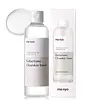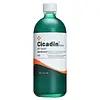What's inside
What's inside
 Key Ingredients
Key Ingredients

 Benefits
Benefits

 Concerns
Concerns

No concerns
 Ingredients Side-by-side
Ingredients Side-by-side

Water
Skin ConditioningGalactomyces Ferment Filtrate
HumectantGlycerin
HumectantButylene Glycol
HumectantPropanediol
SolventPentylene Glycol
Skin ConditioningOryza Sativa Bran Extract
Skin ConditioningPhaseolus Radiatus Seed Extract
Skin ConditioningGlycine Soja Seed Extract
Skin ConditioningSalix Alba Bark Extract
AstringentCarica Papaya Fruit Extract
Skin ConditioningRosmarinus Officinalis Leaf Extract
Antimicrobial1,2-Hexanediol
Skin ConditioningPanthenol
Skin ConditioningBetaine
HumectantAllantoin
Skin ConditioningGluconolactone
Skin ConditioningEthylhexylglycerin
Skin ConditioningCapryloyl Salicylic Acid
ExfoliatingXanthan Gum
EmulsifyingOctanediol
Tocopherol
AntioxidantDisodium EDTA
Water, Galactomyces Ferment Filtrate, Glycerin, Butylene Glycol, Propanediol, Pentylene Glycol, Oryza Sativa Bran Extract, Phaseolus Radiatus Seed Extract, Glycine Soja Seed Extract, Salix Alba Bark Extract, Carica Papaya Fruit Extract, Rosmarinus Officinalis Leaf Extract, 1,2-Hexanediol, Panthenol, Betaine, Allantoin, Gluconolactone, Ethylhexylglycerin, Capryloyl Salicylic Acid, Xanthan Gum, Octanediol, Tocopherol, Disodium EDTA
Water
Skin ConditioningGlycereth-26
HumectantPropanediol
SolventGlycerin
HumectantButylene Glycol
HumectantCentella Asiatica Extract
CleansingDipropylene Glycol
HumectantPentylene Glycol
Skin ConditioningBetaine
HumectantHydroxyethyl Urea
HumectantChondrus Crispus Extract
Skin Conditioning1,2-Hexanediol
Skin ConditioningSaccharum Officinarum Extract
MoisturisingCholeth-24
EmulsifyingTriethylhexanoin
MaskingSqualane
EmollientAcrylates/C10-30 Alkyl Acrylate Crosspolymer
Emulsion StabilisingAmmonium Acryloyldimethyltaurate/Vp Copolymer
Ethylhexylglycerin
Skin ConditioningGlyceryl Glucoside
HumectantTromethamine
BufferingXanthan Gum
EmulsifyingSodium Hyaluronate
HumectantDisodium EDTA
Panthenol
Skin ConditioningCitrus Aurantium Bergamia Fruit Oil
MaskingLavandula Angustifolia Oil
MaskingPinus Sylvestris Leaf Oil
MaskingRosmarinus Officinalis Leaf Oil
MaskingEndomyces Ferment Filtrate
Skin ConditioningAsiaticoside
AntioxidantXylitylglucoside
HumectantAsiatic Acid
Skin ConditioningMadecassic Acid
Skin ConditioningAnhydroxylitol
HumectantXylitol
HumectantRaspberry Seed Oil/Tocopheryl Succinate Aminopropanediol Esters
Skin ConditioningGlucose
HumectantChlorella Vulgaris Extract
Skin ConditioningDiospyros Kaki Calyx Extract
AntioxidantWater, Glycereth-26, Propanediol, Glycerin, Butylene Glycol, Centella Asiatica Extract, Dipropylene Glycol, Pentylene Glycol, Betaine, Hydroxyethyl Urea, Chondrus Crispus Extract, 1,2-Hexanediol, Saccharum Officinarum Extract, Choleth-24, Triethylhexanoin, Squalane, Acrylates/C10-30 Alkyl Acrylate Crosspolymer, Ammonium Acryloyldimethyltaurate/Vp Copolymer, Ethylhexylglycerin, Glyceryl Glucoside, Tromethamine, Xanthan Gum, Sodium Hyaluronate, Disodium EDTA, Panthenol, Citrus Aurantium Bergamia Fruit Oil, Lavandula Angustifolia Oil, Pinus Sylvestris Leaf Oil, Rosmarinus Officinalis Leaf Oil, Endomyces Ferment Filtrate, Asiaticoside, Xylitylglucoside, Asiatic Acid, Madecassic Acid, Anhydroxylitol, Xylitol, Raspberry Seed Oil/Tocopheryl Succinate Aminopropanediol Esters, Glucose, Chlorella Vulgaris Extract, Diospyros Kaki Calyx Extract
Ingredients Explained
These ingredients are found in both products.
Ingredients higher up in an ingredient list are typically present in a larger amount.
1,2-Hexanediol is a synthetic liquid and another multi-functional powerhouse.
It is a:
- Humectant, drawing moisture into the skin
- Emollient, helping to soften skin
- Solvent, dispersing and stabilizing formulas
- Preservative booster, enhancing the antimicrobial activity of other preservatives
Betaine is a common humectant (a substance that promotes retention of moisture). It's known to be gentle on the skin and can help balance hydration.
This ingredient is best for improving hydration and soothing irritated skin. Studies also show it helps even out skin tone.
Fun fact: Betaine is naturally created in the skin and body. The kind found within cosmetic products can be either plant-derived or synthetic.
Another name for betaine is trimethylglycine.
Learn more about BetaineButylene Glycol (or BG) is used within cosmetic products for a few different reasons:
Overall, Butylene Glycol is a safe and well-rounded ingredient that works well with other ingredients.
Though this ingredient works well with most skin types, some people with sensitive skin may experience a reaction such as allergic rashes, closed comedones, or itchiness.
Learn more about Butylene GlycolDisodium EDTA plays a role in making products more stable by aiding other preservatives.
It is a chelating agent, meaning it neutralizes metal ions that may be found in a product.
Disodium EDTA is a salt of edetic acid and is found to be safe in cosmetic ingredients.
Learn more about Disodium EDTAEthylhexylglycerin (we can't pronounce this either) is commonly used as a preservative and skin softener. It is derived from glyceryl.
You might see Ethylhexylglycerin often paired with other preservatives such as phenoxyethanol. Ethylhexylglycerin has been found to increase the effectiveness of these other preservatives.
Glycerin is already naturally found in your skin. It helps moisturize and protect your skin.
A study from 2016 found glycerin to be more effective as a humectant than AHAs and hyaluronic acid.
As a humectant, it helps the skin stay hydrated by pulling moisture to your skin. The low molecular weight of glycerin allows it to pull moisture into the deeper layers of your skin.
Hydrated skin improves your skin barrier; Your skin barrier helps protect against irritants and bacteria.
Glycerin has also been found to have antimicrobial and antiviral properties. Due to these properties, glycerin is often used in wound and burn treatments.
In cosmetics, glycerin is usually derived from plants such as soybean or palm. However, it can also be sourced from animals, such as tallow or animal fat.
This ingredient is organic, colorless, odorless, and non-toxic.
Glycerin is the name for this ingredient in American English. British English uses Glycerol/Glycerine.
Learn more about GlycerinPanthenol is a common ingredient that helps hydrate and soothe the skin. It is found naturally in our skin and hair.
There are two forms of panthenol: D and L.
D-panthenol is also known as dexpanthenol. Most cosmetics use dexpanthenol or a mixture of D and L-panthenol.
Panthenol is famous due to its ability to go deeper into the skin's layers. Using this ingredient has numerous pros (and no cons):
Like hyaluronic acid, panthenol is a humectant. Humectants are able to bind and hold large amounts of water to keep skin hydrated.
This ingredient works well for wound healing. It works by increasing tissue in the wound and helps close open wounds.
Once oxidized, panthenol converts to pantothenic acid. Panthothenic acid is found in all living cells.
This ingredient is also referred to as pro-vitamin B5.
Learn more about PanthenolPentylene glycol is typically used within a product to thicken it. It also adds a smooth, soft, and moisturizing feel to the product. It is naturally found in plants such as sugar beets.
The hydrophilic trait of Pentylene Glycol makes it a humectant. As a humectant, Pentylene Glycol helps draw moisture from the air to your skin. This can help keep your skin hydrated.
This property also makes Pentylene Glycol a great texture enhancer. It can also help thicken or stabilize a product.
Pentylene Glycol also acts as a mild preservative and helps to keep a product microbe-free.
Some people may experience mild eye and skin irritation from Pentylene Glycol. We always recommend speaking with a professional about using this ingredient in your routine.
Pentylene Glycol has a low molecular weight and is part of the 1,2-glycol family.
Learn more about Pentylene GlycolPropanediol is an all-star ingredient. It softens, hydrates, and smooths the skin.
It’s often used to:
Propanediol is not likely to cause sensitivity and considered safe to use. It is derived from corn or petroleum with a clear color and no scent.
Learn more about PropanediolWater. It's the most common cosmetic ingredient of all. You'll usually see it at the top of ingredient lists, meaning that it makes up the largest part of the product.
So why is it so popular? Water most often acts as a solvent - this means that it helps dissolve other ingredients into the formulation.
You'll also recognize water as that liquid we all need to stay alive. If you see this, drink a glass of water. Stay hydrated!
Learn more about WaterXanthan gum is used as a stabilizer and thickener within cosmetic products. It helps give products a sticky, thick feeling - preventing them from being too runny.
On the technical side of things, xanthan gum is a polysaccharide - a combination consisting of multiple sugar molecules bonded together.
Xanthan gum is a pretty common and great ingredient. It is a natural, non-toxic, non-irritating ingredient that is also commonly used in food products.
Learn more about Xanthan Gum